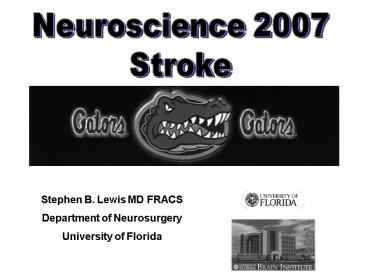Stephen B. Lewis MD FRACS - PowerPoint PPT Presentation
1 / 26
Title:
Stephen B. Lewis MD FRACS
Description:
Symptoms due to SAH: - sentinal headache - 'worst headache of life' ... Symptoms due to location - mass effect on optic nerve. Stroke: hemorrhagic strokes ... – PowerPoint PPT presentation
Number of Views:49
Avg rating:3.0/5.0
Title: Stephen B. Lewis MD FRACS
1
Neuroscience 2007 Stroke
Stephen B. Lewis MD FRACS Department of
Neurosurgery University of Florida
2
- General overview
- Ischemic stroke a) Thrombotic vs
embolic b) Factors affecting extent c)
Effect of location c) Lacunar c)
Territorial - Hemorrhagic stroke a) Aneurysms b)
Hypertension - Cerebral herniation
3
A sudden and often severe cerebral vascular
catastrophe that may temporarily or permanently
impair brain function
Types 1. Ischemic blockage within blood
vessel a. Thrombotic locally generated
obstruction b. Embolic occlusion secondary
to traveling particle originating
proximally in bloodstream 2. Hemorrhagic
bleeding from blood vessel resulting in
clot formation within brain
substance or over its surface
4
Favored locations
- Heart
- Sites of atheromatous disease - aorta -
common carotid bifurcation - distal
intracranial vertebral artery - proximal half
basilar artery - perforating microvessels
5
- Emboli lodge at bifurcations - ICA
bifurcation - basilar artery tip - Final lodgement a function of - hemodynamic
forces - size - Perforator (lacunar) strokes - thrombotic (local
disease) - Territorial strokes - embolic or thrombotic
MCA
ACA
Basilar apex
PCA
Basilar A.
Vertebral A.
6
Stroke factors affecting extent of stroke
- Anastomotic channels - ACoA -
PCoA - Between territories
7
Clinical example when things fail
Stroke factors affecting extent of stroke
- 46 yo rh WM
- Carpenter
- Very hot day dehydrated, felt unwell
- Sudden onset of leg weakness
8
Stroke factors affecting extent of stroke
- Perforating vessels - end arteries - poor
collateral supply - lenticulostriates affected
Lenticulostriates
Sylvian Fissure
A2
HA
M1 (pre-bifurcation)
M1 (post-bifurcation)
M2 segments
Genu
M3 segments
ICA
M4 segments (cortical branches)
M4
9
- Small perforating vessels - may be silent
(lacunes in putamen, others) - may be devastating
(lenticulostriates)
- Terminal large vessel occlusion - large number of
syndromes - MCA upper div facio brachial
motor, hemisensory loss, Brocas aphasia - MCA
lower div Wernickes aphasia, visual
disturbance, behavioural
10
- Terminal large vessel occlusion - dependent
upon territory supplied
- PICA a) Vestibular nuclei
NV b) Inf cereb peduncle ipsi
ataxia c) Spinal CN V ipsi PT face d)
CN IX loss afferent limb gag rf e) CN X
ipsi pharyngeal, laryngeal
paralysis f) Spinal lemniscus (ST
tract) contra. PT from limbs
trunk g) Desc sympathetics ispi Horners
11
- One-third of all ischemic strokes
- Etiology arteriosclerotic occlusion of
perforators in the basal
ganglia, brainstem, and
centrum semiovale - Associated with HTN and diabetes
- Lesions lt 1.5 mm3 (often not seen on CT)
12
Clinical example
- 56 yo rh WF
- Diabetes, hypertension, smoker
- Sudden onset left pure motor hemiparesis
- Classical clinical syndromes
- - Pure motor
- - Pure sensory
13
- Two-thirds of all ischemic strokes
- Arterial branch or stem occlusions
- Etiology embolic or local thrombosis
- Prognosis related to severity of presenting
symptoms, size of lesion, and patients age
comorbidities
14
Onset of clinical symptoms
100
EMBOLIC STROKE THROMBOTIC STROKE
NORMAL NEUROLOGIC FUNCTION
0
minutes
hours
days
years
months
TIME
15
- Supratentorial
- - sudden motor/sensory deficit
- - plus cortical symptoms such as aphasia,
apraxia, neglect, homonymous visual deficits
Infratentorial - sudden motor/sensory deficit -
Plus additional brainstem or cerebellar
disturbances
16
Cerebral aneurysms
- Cerebral arteries have subarachnoid course
- Aneurysms outpouching of intima
- Aneurysms occur at bifurcation points
ACoA 35
MCA 20
P Comm 25
Basilar 10
Vertebral 5
17
Cerebral aneurysms
- Symptoms due to SAH - sentinal
headache - worst headache of life
18
Cerebral aneurysms
- Symptoms due to location - mass effect on
optic nerve
- 49 yo rh W M
- Gradual onset - bumping into
things - inferior nasal field cut right eye
19
(No Transcript)
20
Hypertensive hemorrhage
- Rupture occurs in middle/distal portions of
penetrating arteries - Incidence doubles with each decade after age 35
- Hypertensive history (remote recent)
- Occurs basal ganglia, thalamus, cerebellum,
pons, deep white matter
21
- Rigid structure
- Contains - brain - blood - CSF
- Additional contents may result in raised pressure
22
Causes of raised ICP
23
Cerebral herniation - effect of raised ICP
24
Subfalcine herniation
- Anterior cerebral artery
- - medial surface
25
- Uncal herniation compressing PCA onto 3rd cranial
nerve
L
R
PCA occlusion - occipital lobe infarction
26
- General overview
- Ischemic stroke a) Thrombotic vs
embolic b) Factors affecting extent c)
Effect of location c) Lacunar c)
Territorial - Hemorrhagic stroke a) Aneurysms b)
Hypertension - Cerebral herniation































